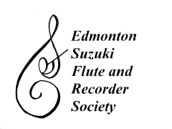
More about Group Classes
The ESFRS group class program has one goal: to give the students the ability to get together with a group of friends and make music together, without needing a conductor or director. Taking ownership of this social aspect of music-making involves learning to play what is often termed “chamber music”: music where each performer plays an individual part, and the parts weave together like a tapestry to create the whole music. This is the same type of ensemble skill required to play the wind instrument parts in a symphony orchestra, which are also often one instrument to a part. There are ample opportunities in school and community band programs for students to play in large sections with multiple instruments on one part. The ESFRS program is unique in its emphasis on each member of the group being a soloist within the ensemble.
There are four levels of group classes in the ESFRS program:
-
•Toolbox group
-
•Repertoire group
-
•Reading group
-
•Silverwinds & Sweetwoods
Sometimes all four groups play together in multi-level combinations, and sometimes they work separately. When they work separately, this is what they do:
Toolbox group:
This is the group in which the students develop their “toolbox” of skills and short pieces. We work on rhythm, pitch, taking turns and playing together, and then combine these skills to play our first short pieces together. Since this group includes all the beginners, it is also the youngest group, so we play lots of fun games too! Parent participation is required of beginner parents, so you can learn together with your child.
Repertoire group:
Although elements of music reading may be introduced as supplementary material, the emphasis in this group is on playing the familiar repertoire in unison, by memory, in order to be free to concentrate on important skill development necessary for successful ensemble playing and expressive performance. Some part playing will be introduced in the form of quodlibets and ostinatos, so that any harmony parts will contain elements that the students already know, so they can focus on the art of playing together without having to worry about also learning new music. This is an important class for beginners to stay and observe, as it provides lots of additional opportunities for observing other students acting as role models.
Reading group:
Individual lesson teachers recommend their students for this group once they demonstrate ease of music reading in their individual lessons. We do not try to teach music reading in a class situation - this is done in individual lessons. Once students can read music, the class introduces them to score reading and music with multiple parts. This also provides opportunities to explore other styles of music outside of the Suzuki repertoire, as well as elements of improvisation and composition. Fluency in score reading also facilitates more performance in multi-level groups - the reading group may join with the Silverwinds or Sweetwoods groups for some performances. Interaction with the senior students also provides important role models, peer support and inspiration for continuing study as the students enter their adolescent years.
Silverwinds & Sweetwoods:
These are the groups that involve the more advanced students in more challenging ensemble experiences and provide extra opportunities for public performance (Celebrate the Season at the Provincial Legislature, Musicians in the Making at the Winspear Centre for Music, Kiwanis Music Festival at Grant McEwan University, etc.). Some of the extra performances and our annual workshop retreat will fall on days other than Thursday, so participation in these groups requires an additional level of commitment. Students may remain in the reading group if they are unable to commit to the extra events. Sweetwoods and Silverwinds students meet the following criteria:
-
•they have completed their Book 2 graduation
-
•they are in junior high school
-
•they have a good attendance record in their previous group classes
-
•they are able to make a commitment to be available for extra performance and workshop events
Music is a social art. Like all performing arts, it relies on direct communication between the performer and the audience. A painter can leave the room and let the painting be viewed, and the author can leave the room while the story is read, but the performer has to be present with the audience in order to present a performance. Group class is an opportunity for students to practice performing.
“In the classroom there are private lessons and group lessons. Parents who do not understand children think they are paying for the private lessons and that the group lessons are just recreation periods. So although they make sure that their children attend the private lessons, they often fail to bring them to group lessons. But the fact is that what the children enjoy most is the group playing. They play with children who are more advanced than they are; the influence is enormous and is marvelous for their training. This is the real talent education.”
Shinichi Suzuki